
Medicine Containers Page Menu: 1 2 3 4 5 6 7 Next>>
Medicine Containers Used In the Golden Age of Piracy, Page 1
"William Green, a sailmaker on the Guinea Hen of Barbados, taken [by pirate Howell Davis] off the Isle of May… recalled that… he refused to handle a pistol during an attack. Davis pressed him so hard to take it that the pistol went off, shooting a hole through Dr. Murray’s valuable medicine chest and breaking a number of bottles inside. For that he was brought to the mast and flogged to within an inch of his life." (Eric J. Graham, Seawolves: Pirates & the Scots, 2005, p. 117)
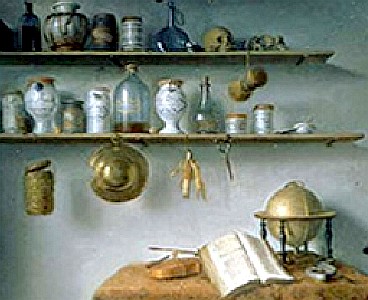
Artist: Isaack Koedijck
Surgeon's Containers Detail From Barber-Surgeon Tending a
Peasant's Foot
(1649-50)
As sail maker Green discovered, medicine containers played an important, if often unrecognized, role in the lives of the pirates. There were a variety of ways medicines were stored at this time. As Robert Opie so eloquently puts it, "All the pills, powders and potions ever made have needed containers of some sort; there have been glass phials and bottles, stone pots and jars, paper wrappers and cardboard or wooden boxes."1
The need for effective medicine containers was particularly important shipboard because all the medicines and ingredients that the ship's surgeon would require on a voyage, needed to be on board when the ship left port. The containers had to preserve these medicines and ingredients until they were needed in the weeks, months or sometimes years following. Such containers also needed to be made of a material that would adequately protect and contain the medicines they were holding. This resulted in apothecary and sea surgeon writers recommending different sorts of medicines be kept in various types of containers.
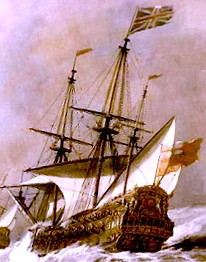
Artist: William van de Velde II
HMS Resolution in Water
(late 17th c.)
At its best, a wooden ship is a damp environment, with water collecting in the hold, one level below the orlop deck, where the ship's surgeon's operating theater was usually located. Stephen Bown points out that the wood of the ship "quickly became waterlogged, creating a permanently damp and cold environment. Men lived in the damp, worked below decks in the damp, slept in the damp, and ate food that was continuously stored in the damp."2 As a result, the method of keeping container closed was crucial for keeping the medicines in and the outside environment out.
Medicines would be stowed in the sea surgeon's chests (which are actually medicine containers themselves, albeit specialized ones that have their own article). During the golden age of piracy, there would be two chests that contained medicines. The first would be the medicine chest itself, a large wooden box containing about 100 - 160 medicines in containers.3 The second would be an instrument chest where medicines such as dried herbs and seeds might be kept so that they would not be spoiled by spills of liquid medicines that could occur in the medicine chest. The surgeon also needed to be able to locate medicines quickly, so charting [such as the diagram below] and labelling of the medicines was another important element of effectively containing them.
 John Woodall Surgeon's Chest Diagram - For Pasting Inside of the Lid to Help the Surgeon Find Medicines (1639) |
This article examines the types of medicine containers that were used, discussing glass, ceramic and metal containers, and finishing with a brief look at wood, paper, leather, cloth and animal bladder containers. It will follow with a look at how containers were closed as well as the way they were labeled during this period.
1 Robert Opie, The Art of the Label: Design of the Times, 1987, p. 39; 2 Stephen R. Bown, Scurvy: How a Surgeon, a Mariner, and a Gentleman Solved the Greatest Medieval Mystery of the Age of Sail, 2003, p. 19; 3 This is based on information found in both John Woodall's 1639 book the surgions mate and John Moyle's 'Exemplary Invoyce' found on pages 30-35 in his 1693 book The Sea Chirurgeon. Many of Moyle's listed ingredients such as seeds and other raw herbs would not be placed in the medicine chest, so a figure of 100 is an estimated based on the number of powders, waters, oils, and unguents he includes. For more information on the actual medicines, see the article The Sea Surgeon's Dispensatory.
Glass Containers
"It remaines now that I direct you to take such care in putting up your Medicines, that they may be preserved good as long as possible. To do this, put up as many things as you can in Jars, Glasses and Boxes." (John Moyle, Abstractum Chirurgæ Marinæ, 1693, p. 13)
Glass containers have a long pedigree in the history of medicine. The ancient Greeks and Romans used them as medicine receptacles; first century Greek physician Pedanis Dioscorides says in the introduction to his seminal
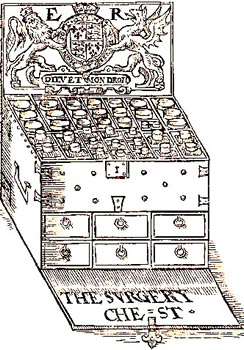
The Medicine Chest from William Clowes' A
Profitable and Necessarie Booke of
Obseruations, p. 140
(1596)
1st century book De Materia Medica that "For liquid medicines, a through and through dense container of (substance) silver, glass or horn is manufactured"1. When Guy's Hospital opened in early 1726, "over 200 glass containers were bought for the new apothecary shop... there being no evidence of a similar purchase of pottery ware."2
Perhaps more directly relevant to sea surgeons, the illustration of a military medicine chest found in William Clowes' 1588 book A Prooued Practise for All Young Chirurgians, Concerning Burnings with Gunpowder, and Woundes Made with Gunshot, Sword, Halbard, Pyke, Launce, Or Such Other is shown containing 36 bottles of medicine in the top of the chest. "George Solly, apothecary to Charles II, was appointed to make these cases for both naval and land warfare."3
A later drawing of the chest is found in his 1596 book A Profitable and Necessarie Booke of Obseruations which contains 39 bottles. The extra three bottles make an important point. While the 1588 version suggests that the bottles were all the same size, the 1596 shows bottles of varying sizes. This agrees with the suggestion in John Woodall's chart of the medicines found in his chest which shows different sized spaces being allotted to various medicines.
We will begin the discussion of glass containers with information given by writers of dispensatories and a military surgeon about what types of medicines were best kept in glass containers. Building on the idea that glass containers found in the medicine chest varied, we will also look at the materials used, the shape of the bottles and the various sizes that may have been employed.
1 Pedanis Dioscorides, De Materia Medica, Translated into German by Julius Berendes, 1904, Translated into English by the author, p. 66; 3 J.K. Crellin and J.R. Scott, Glass and British Pharmacy 1600-1900, F.N.L. Poynter, Editor, Wellcome Institute of the History of Medicine, London, 1972, p. 1; 3 Elizabeth Bennion, Antique Medical Instruments, p. 273-6
Glass Containers - Use For Medicines
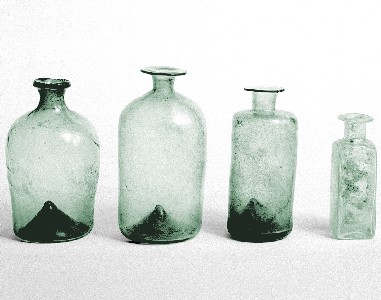
18th Century Medicine Bottle in the Wellcome Collection (Note: image is tinted)
Several medical authors point specifically to glass for holding specific medicines in their dispensatories. Among them, physician William Salmon advised glass be used for Salt of Hartshorn (smelling salts)1 and Extract of Colquintida.2 Apothecary John Quincy recommended keeping Essence of Canthrides3 and Spirit of Nitre4 in glass. Physician Robert James advised putting Camphor5 in glass (perhaps as much to keep the air in as out in that case). And Jean de Renou suggests putting Turpentine in glass.6
Other medical authors recommend keeping entire classes of medicines in glass. In The English Physitian Enlarged, English physician Nicholas Culpeper suggests that distilled waters7, syrups8, decoctions [syrups made for shorter term use]9 oils10 and preserves11 can all be well kept in glass containers. French physician Jean de Renou advises putting oils, juices, balsams, dried seeds, powders and "Water-drops, Gums, whole or parts of Animals and Minerals"12 in glass vessels in his 1657 book A Medical Dispensatory.
Of course, Culpeper and Renou were talking about how to keep medicine in stationary, land-based locations. German military surgeon, William Fabry explained to military and sea surgeons how to stow medicines for use in his book Cista Militaris, Or, A Military Chest, Furnished Either for Sea or Land. Fabry advised that "Syrups, and distil'd Waters, are to be put into double Glasses"13. He also suggested "Oyls, and common Balsams, [are to be put] in Glass-bottles ...but the pretious [precious] Chymical Oyls, as of Cinnamon, Cloves, Maces, Nutmegs, &c. ought to be preserv'd in double Glasses.... The Balsams likewise of these are to be kept in Glasses, or Silver."14
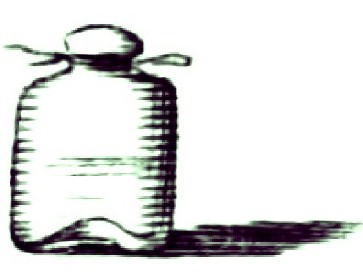
Pierre Dionis' Figure of a Caustic Bottle, From Cours d'Operations de
Chirurgerie, p. 578 (1708)
Fabry also talked about placing caustic medicines in glass, with an additional note about where they are to be located.
"Arsnick, Orpiment [arsenic sulfide], crude mercury, [mercury] sublimate, [mercury] præcipitate, caustic, Minium [red lead] Troches, Spirit of Vitriol, Aqua fortis, and the like corrosive Medicines, are not to be plac’d in the Chest, lest the Glass, or what other things they are contained in, break, and so spoil and prejudice the other Medicines and withal endanger the lives of the sick; therefore to prevent this, it is more convenient to keep them in some Box or Chest apart by themselves."15
French surgeon Pierre Dionis similarly recommended keeping caustic stones in glass bottles, advising his readers to take the "small Stones which we putt into Glass Vials, and stopping them very well, keep them in a warm and dry place."16
While Dionis doesn't directly discuss medicine containers in his book A Course of Operations, he does mention them in explaining how various operations are to be performed. Dionis' book is heavily illustrated with simple line drawings of all the tools needed for each operation, which includes several glass containers as seen below. It should be noted that these would be used in a stationary, land-based practice; most bottles found on ships were likely to have been simpler, like Dionis' caustic bottle.
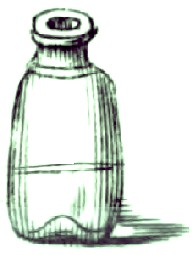 Glass Styptic Water Container, From Pierre Dionis' Cours d'Operations de Chirurgerie, p. 520 (1708) |
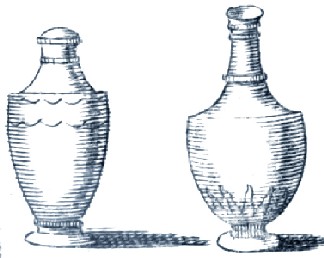 Glass Containers for Spirit of Wine and Hungary Water, From Pierre Dionis' Cours d'Operations de Chirurgerie, p. 522 (1708) |
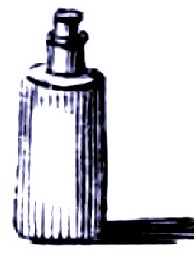 White Balsam Glass Viol Container, Pierre Dionis' Cours d'Operations de Chirurgerie, p. 359 (1708) |
All of the sea surgeons mention the use of glass vessels to contain medicines. Naval author John Atkins commented that "the first Business [of a warranted naval surgeon] ...should be to acquaint Apothecaries-Hall; [so] that [the] Chest, Instruments, Pots, and Glasses may be in Readiness and suited to Fancy."17 (By 'Pots,' he is referring to ceramic or stone vessels.) While he doesn't discuss containers in detail, sea surgeon John Woodall occasionally mentions them in relation to his medicines. For example, he notes that when using barley water the surgeon should "keepe it not in the brasse pott, but in some earthen or glasse vessell"18. He also mentions keeping mercury in a glass container19 and says that white vitriol (zinc sulfate) should be stored "in a glasse close stopped"20. Perhaps the most specific instructions come from sea surgeon John Moyle who advises, "Let all your Jars and Glasses both great and small be square, and not round, that they may stow the better; and let them be all strong, double Glasses, that will not break upon a slight occasion."21
1 William Salmon, Pharmacopoeia Bateana, 1710, p. 497; 2 Salmon, p. 274; 3 John Quincy, Pharmacopoeia Officinalis & Extemporanea, p. 301; 4 Quincy, p. 277; 5 Robert James, Pharmacopœia universalis, 1747, p. 271; 6 Jean de Renou, A Medicinal Dispensatory, p. 156; 7 Nicholas Culpeper, The English Physitian Enlarged, 1666, p. 275; 8 Culpeper, p. 276; 9 Culpeper, p. 277; 10 Culpeper, p. 278; 11 Culpeper, p. 281; 12 Jean de Renou, A Medicinal Dispensatory, 1657, p. 146;13,14 Guiliem. Fabritius Hildanus aka. William Fabry. Cista Militaris, Or, A Military Chest, Furnished Either for Sea or Land, 1674, p. 10; 15 Fabry. p. 11-2; 16 Pierre Dionis, A course of chirurgical operations: demonstrated in the royal garden at Paris. 2nd ed., 1733, p. 468; 17 John Atkins, "Introduction," The Navy Surgeon, not paginated; 18 John Woodall, the surgions mate, 1617, p. 36; 19 Woodall, p. 298; 20 Woodall, p. 284; 21 John Moyle, Abstractum Chirurgæ Marinæ, p. 14
Glass Containers - Protection From Breakage
One of the problems of using glass containers was their potential to break.
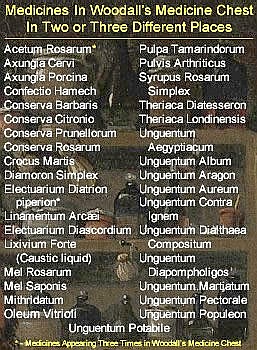
From John Woodall's the surgions mate,
Chart found opp p. 26. Image by David
Teniers the Younger (17th Century)
On land, this was unfortunate and potentially expensive. At sea, bottle breakage could be far more problematic. Once a glass vial of medicine broke and its contents spilled, that medicine would not be available to the surgeon for treatment until the ship stopped in a port where the surgeon could purchase a replacement. It could be months before he might have such an opportunity, so he would have to either find a substitute medicine or go without. This might explain the pirates violent reaction to sail maker Green's unfortunate shot into the medicine chest.
The concern about breakage may also be the reason John Woodall includes multiple containers of the same medicine in his medicine chest; 31 of his medicines appear in two places in the chest and 2 medicines appear in three places.1 (A list of these medicine can be found in the chart at right.) Woodall often places them in different parts of the chest, perhaps as a form of added protection.
German physician William Fabry, writing about military medicine chests for land and sea recommends using double glass bottles that are "so plac'd that they may not move, and so break each other, and their cells lined with Baiz [baize - coarse wool cloth]."2
Sea surgeon John Moyle also gives some detail on how to protect glass containers shipboard. 
John Moyle (1693)"Let all your Jars and Glasses both great and small be square, and not round, that they may stow the better; and let them be all strong, double Glasses, that will not break upon a slight occasion."3
Like Fabry, Moyle also indicates that baize lining in the compartments can help protect glass bottles in the chest, noting that if they "are not lined with Bayes, you must wrap your Jars and Bottles in Towe [lint], to preserve them from breaking in carriage or removing."4 He goes even further, advising, "It hath been accustomary to put them [glass bottles] into Bladders, as well to save what is in them, (if any one should chance to break) as to preserve other Medicines from being spoiled, by the Oyles or Corrosives, if they should spill, but good double Jars and Glasses prevent that."5 (By 'bladders' he means animal bladders such as pig, sheep, cow and goat bladders. Being elastic they would hopefully contain the broken glass and medicine if the container broke. Bladders had several other, related uses as we shall see.)
Moyle was also concerned about the problem of fermenting medicines. Many of the waters in use in medicine at this time were distilled. With this in mind, Moyle warns the reader to make sure "each Jar or Bottle, that you carry your Fermenting Medicines in, be larger than to hold the quantity you put in them, that there may be room to ferment, and let them be covered well that the Air spoil them not."6
Moyle
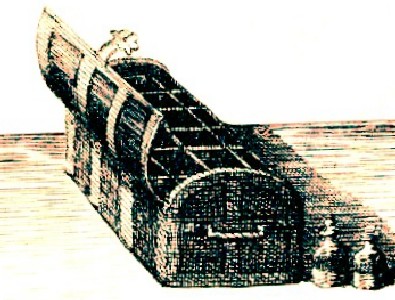
Source: British Museum
Medicine Chest with Partitions in Top Section, From
The Infallible Montebank;
Or Quack Doctor (1690)
(Note: This Is Not a Sea Surgeon's Medicine Chest)
goes even further, commenting on the design of the medicine chest itself that will best protect glass and ceramic containers.
Now for the greater safety of your Medicines, let me advise you, not to have drawing Boxes at the Ends of the bottom of your Chest [a box on rails that can be slid from side to side or removed in order to access something below], as some use to have... for when you shall need any thing that is in them, you must take out several Medicines that stand in the bottom of the Chest before them; which [ceramic] Pots or Glasses will be in danger of breaking, especially if there goes a great Sea, and the Ship rouls.7
Moyle gives details on where different-sized glass bottles should be placed for optimal protection. He explains that the chest should "have Partitions all over the bottom, and let those partitions be bigger than them at top; and in them place your greatest Jars and Glasses (and especially your Oyles and Corrosive Medicaments, that if they should spill or break, they cannot fall on others to dammage them)".8
1 Bssed on Information Found in the Medicine Chest Chart in John Woodall's the surgions mate, 1617, opp. p. 26; 2 Guiliem. Fabritius Hildanus aka. William Fabry. Cista Militaris, Or, A Military Chest, Furnished Either for Sea or Land, 1674, p. 10; 3 John Moyle, Abstractum Chirurgæ Marinæ, 1686, p. 14; 4 John Moyle, The Sea Chirurgeon, 1693, p. 42-3; 5 Moyle, Abstractum, p. 14; 6 Moyle, Sea Chirurgeon, p. 41-2; 7 Moyle, Abstractum, p. 15-6; 8 Moyle, Sea Chirurgeon, p. 43

